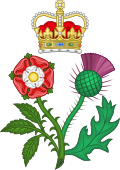
Mayfair is an area of London, England, in the City of Westminster. It is in Central London and part of the West End. It is between Oxford Street, Regent Street, Piccadilly and Park Lane and one of the most expensive districts in the world.

Henry Pelham was a British Whig statesman who served as Prime Minister of Great Britain from 1743 until his death in 1754. He was the younger brother of Thomas Pelham-Holles, 1st Duke of Newcastle, who served in Pelham's government and succeeded him as prime minister. Pelham is generally considered to have been Britain's third prime minister, after Robert Walpole and the Earl of Wilmington.
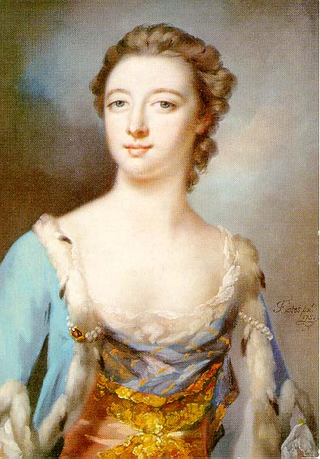
Elizabeth Campbell, Duchess of Argyll, 1st Baroness Hamilton of Hameldon, earlier Elizabeth Hamilton, Duchess of Hamilton, née Gunning, was a celebrated Anglo-Irish beauty, lady-in-waiting to Queen Charlotte, and society hostess.

A Fleet marriage was a common example of an irregular or a clandestine marriage taking place in England before the Marriage Act 1753 came into force on March 25, 1754. Specifically, it was one which took place in London's Fleet Prison or its environs during the 17th and, especially, the early 18th century.

James Hamilton, 2nd Duke of Abercorn, styled Viscount Hamilton until 1868 and Marquess of Hamilton from 1868 to 1885, was a British nobleman, courtier, and diplomat. He was the son of James Hamilton, 1st Duke of Abercorn, and Lady Louisa Jane Russell.

Albemarle Street is a street in Mayfair in central London, off Piccadilly. It has historic associations with Lord Byron, whose publisher John Murray was based here, and Oscar Wilde, a member of the Albemarle Club, where an insult he received led to his suing for libel and to his eventual imprisonment. It is also known for its art galleries and the Brown's Hotel is located at 33 Albemarle Street.
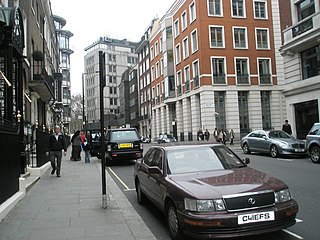
Curzon Street is a street in Mayfair, London, within the W1J postcode district, that ranges from Fitzmaurice Place, past Shepherd Market, to Park Lane. It is named after Sir Nathaniel Curzon, 2nd Baronet, who inherited the landholding during 1715. More houses were built there during the 1720s.
Harry Powlett, 4th Duke of Bolton PC, known until 1754 as Lord Harry Powlett, was a British nobleman and Whig politician. He sat in the House of Commons from 1715 to 1754, when he took his seat in the House of Lords.
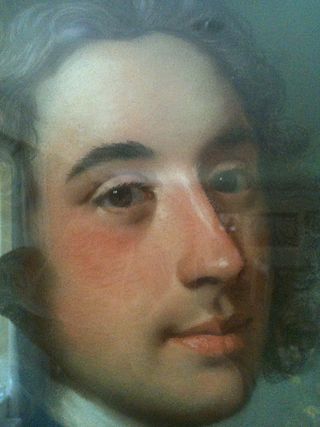
Charles Fane, 2nd Viscount Fane was a landowner in Ireland and England, a Whig Member of Parliament and the British Resident in Florence.

Lord Archibald Hamilton was a Royal Navy officer, nobleman and Whig politician who sat in the House of Commons from 1708 to 1747. In the 1690's, he was active in the English Channel pursuing French privateers, including Tyger out of Saint-Malo. Hamilton commanded the third-rate HMS Boyne at the Battle of Vigo Bay in October 1702 and then commanded the third-rate HMS Eagle at the Battle of Málaga in August 1704 during the War of the Spanish Succession. He was a controversial governor of Jamaica. Hamilton then joined the Board of Admiralty, ultimately serving as Senior Naval Lord.

St Peter, Vere Street, known until 1832 as the Oxford Chapel after its founder Edward Harley, 2nd Earl of Oxford and Earl Mortimer, is a former Anglican church off Oxford Street, London. It has sometimes been referred to as the Marybone Chapel or Marylebone Chapel.

James Brydges, 3rd Duke of Chandos, PC, styled Viscount Wilton from 1731 to 1744 and Marquess of Carnarvon from 1744 to 1771, was an English politician.

Hannah Lightfoot, known as "The Fair Quaker", was a Quaker in Westminster. She married Isaac Axford in December 1753 but, before the end of the following year, had disappeared. Later gossip, originally in amusement and ridicule, first noted in print in 1770, but much embroidered in the late eighteenth and early nineteenth centuries linked her name, although some eight years his senior, with the extremely shy fifteen-year-old Prince George. Prince George became King George III in 1760 and was known to admire the simplicity of the Quakers. After George's death, rumours circulated that he had engineered her abduction, married and had children by her. However, no contemporary source connecting the Prince and Hannah has ever been found.

Shepherd Market is a small precinct in Mayfair, in the West End of London. Featuring two business-lined squares, it is between Piccadilly and Curzon Street and has a village-like atmosphere. It was built up between 1735 and 1746 by Edward Shepherd on the open ground then used for the annual fair from which Mayfair derives its name. In the 1920s, it hosted leading writers and artists such as Anthony Powell, Michael Arlen and Sophie Fedorovitch. It was associated with upmarket prostitutes until at least the 1980s. Jeffrey Archer met Monica Coghlan there in the 1980s.
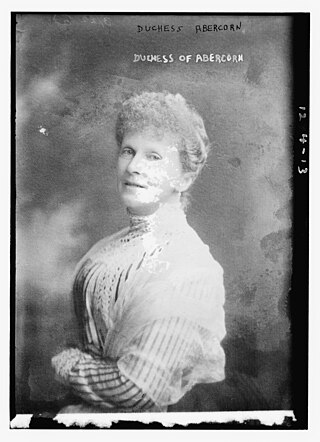
Mary Anna Hamilton, Duchess of Abercorn, was an English courtier and aristocrat. She served as Lady-in-Waiting to Queen Alexandra.
Michael Lort (1725–1790) was a Welsh clergyman, academic and antiquary.
Arthur Henry Aylmer Morton was a British clergyman, schoolteacher and Conservative Party politician.
Lord George Bentinck was a British Army officer and Member of Parliament (MP).

South Audley Street is a major shopping street in Mayfair, London. It runs north to south from the southwest corner of Grosvenor Square to Curzon Street.

Richard Vernon was a British horse breeder and trainer and a politician who sat in the House of Commons between 1754 and 1790.


















